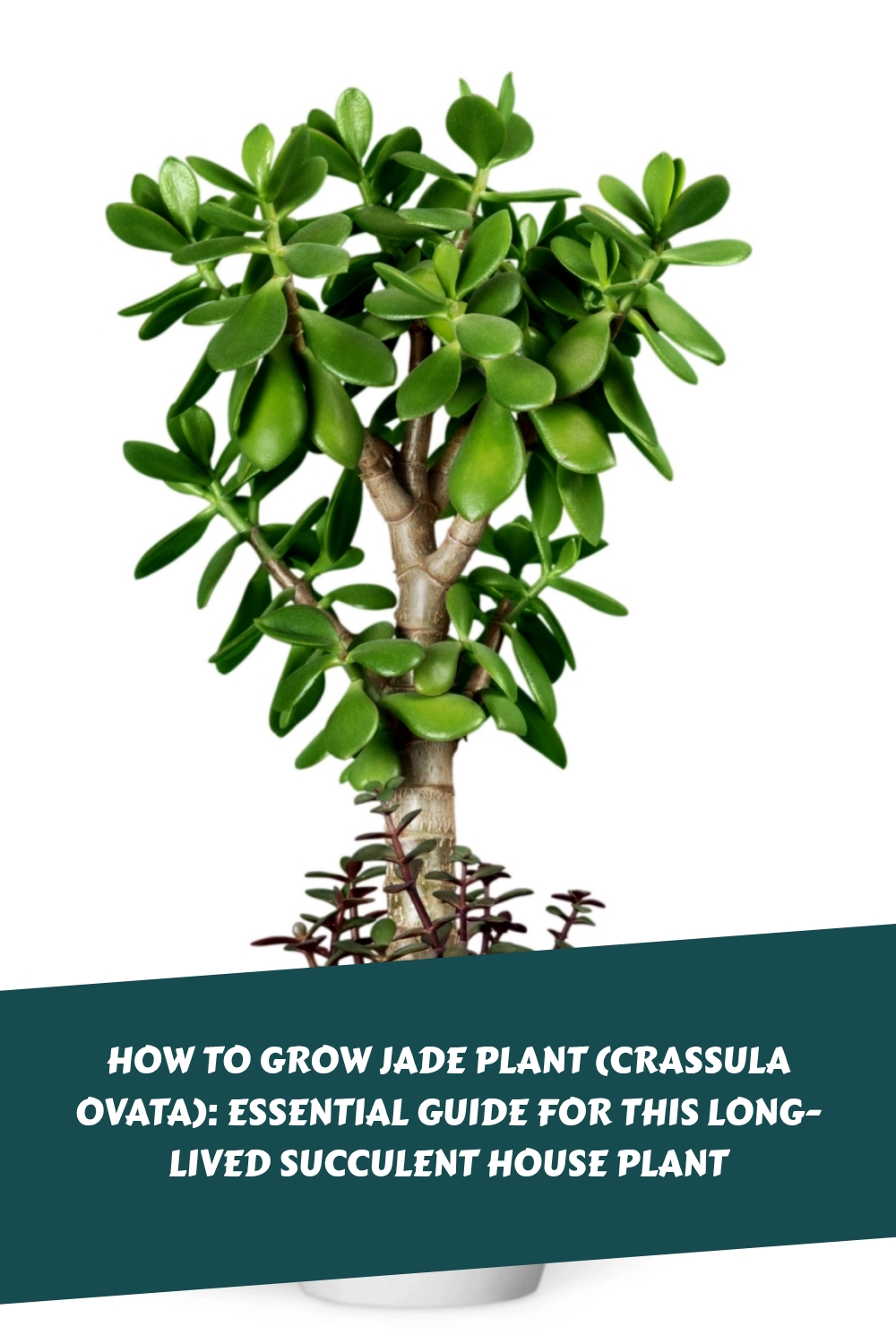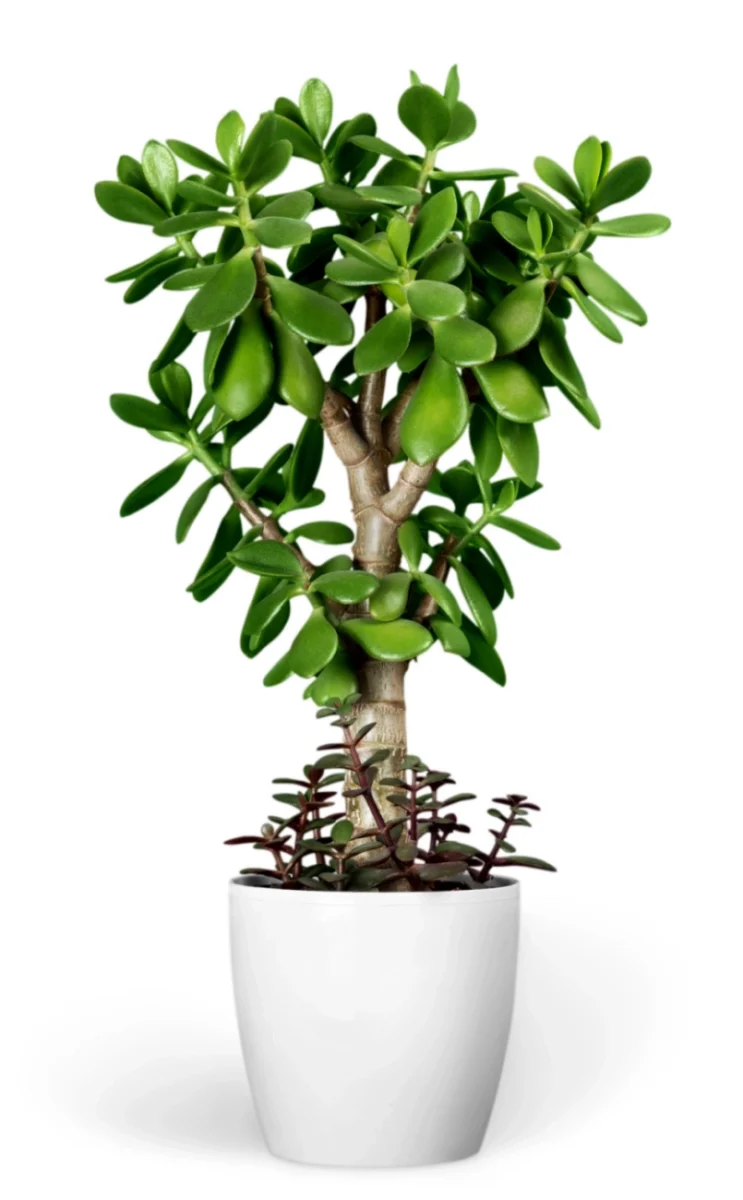
Jade Plants, scientifically known as Crassula ovata, are stunning succulents native to South Africa where they thrive in arid conditions with plenty of sunshine.
These charming houseplants have become incredibly popular not only for their attractive appearance – featuring thick, glossy oval leaves and sturdy woody stems – but also for their symbolic significance in many cultures.
Often referred to as Money Plants, Lucky Plants, or Money Trees, Jade Plants have earned a special place in Feng Shui practices where they’re believed to attract prosperity and good fortune when placed in the right area of your home.
Their tree-like appearance when mature creates a miniature landscape that can elegantly enhance any windowsill, desk or table. The plant’s striking contrast between its rich green leaves and reddish edges (particularly when sun-exposed) makes it a nice addition to any interior space.
Jade Plants are considered easy to care for, making them perfect for beginners, as they require minimal attention, As I can personally attest to, they can forgive neglect due to their ability to store water in their fleshy leaves.
To successfully grow a Jade Plant indoors, you’ll need to provide bright, indirect light for at least 6 hours daily – a south or west-facing window typically works brilliantly. These succulents also prefer the warm, dry conditions found in most homes, and do particularly well in loose, well-draining soil that prevents root rot.
While they don’t demand constant attention, understanding their basic needs will help your Jade Plant not only survive but truly flourish as a beautiful, long-lived addition to your houseplant collection.
Key Takeaways
- Jade Plants thrive in bright indirect light and well-draining soil, requiring minimal watering and making them perfect low-maintenance houseplants.
- These symbolic plants are believed to bring prosperity and good fortune in Feng Shui practices, making them both decorative and meaningful additions to your home.
- Keep Jade Plants in warm, dry conditions similar to their native South African habitat, allowing soil to dry completely between waterings to prevent common issues.
Characteristics Of Jade Plant
Jade Plant (Crassula ovata) is a remarkable succulent native to South Africa that has become a beloved houseplant worldwide. With its thick, woody stems and plump, oval-shaped leaves, this plant exudes a tree-like appearance that adds a touch of elegance to any indoor space.
One of the most notable characteristics of jade plants is their slow growth rate. They typically gain only about two inches in height per year, making them perfect for long-term indoor cultivation. Despite this unhurried development, healthy specimens can eventually reach impressive heights between three and six feet when properly cared for.
These plants are incredibly resilient and long-lived, often becoming heirlooms passed down through generations. Their toughness makes them ideal for beginners.
Key Features:
- Leaves: Fleshy, oval-shaped with a glossy appearance
- Stems: Thick and woody, resembling tree trunks as they age
- Colour: Typically jade green, though varieties like ‘Hummel’s Sunset’ display golden-yellow hues
- Lifespan: Can live for decades with proper care
- Growth habit: Compact and tree-like
Jade plants are particularly well-suited to container growing, thriving in the restricted root space while appreciating warm, dry conditions found in most homes. This adaptability to typical indoor environments contributes to their popularity as houseplants.
With proper care and maturity, jade plants may reward you with delicate star-shaped white or pink flowers, typically appearing during winter in ideal conditions. These blooms add an extra dimension of beauty to an already striking plant.
You can also cultivate jade plants as bonsai specimens due to their amenable nature to pruning and training. Their thick trunks and miniature tree-like appearance make them perfect candidates for this ancient art form.
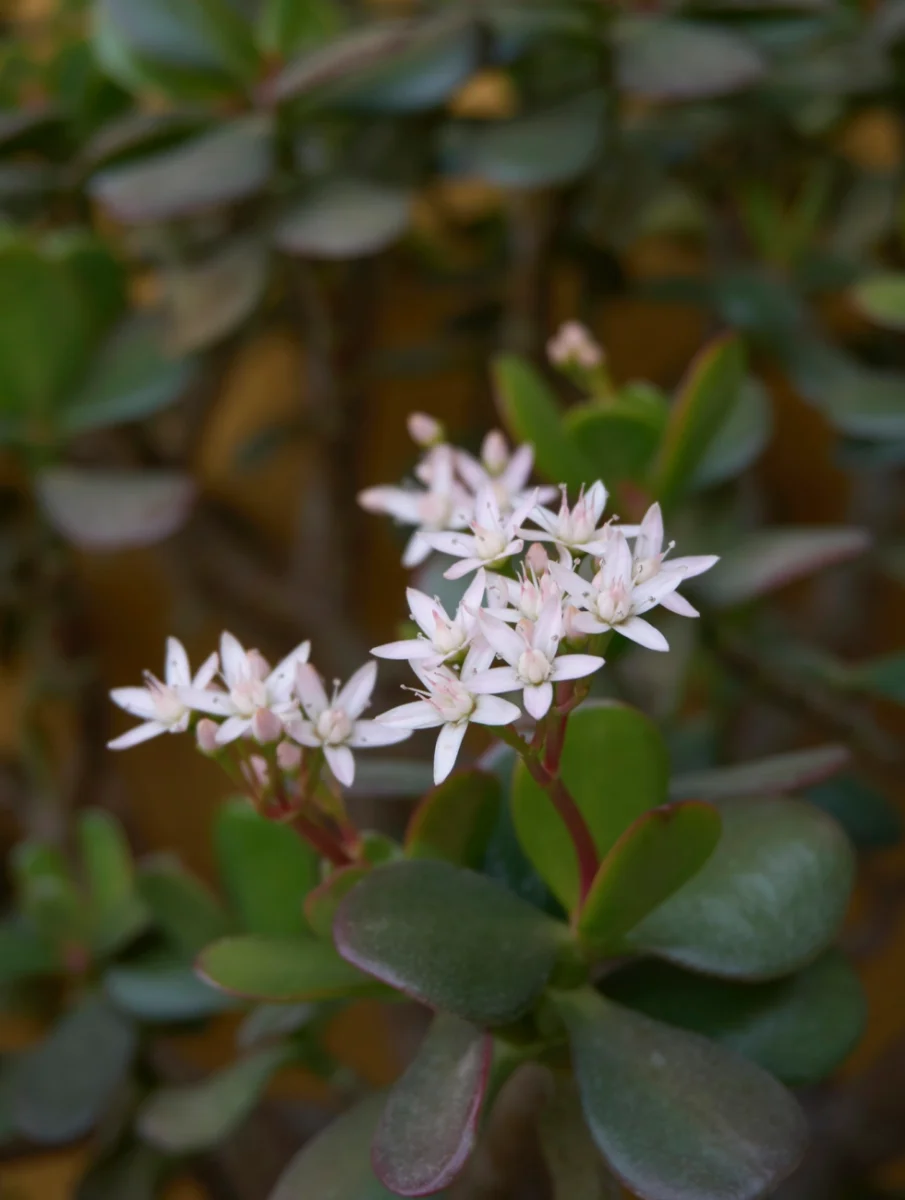
How To Grow Jade Plant
Jade plants are resilient succulents that thrive with minimal care when provided with the right growing conditions. These popular houseplants require specific light, soil, water, and maintenance practices to flourish in indoor environments.
Light Requirements
Jade plants need bright, indirect light to develop their signature thick stems and plump, glossy leaves. A south or west-facing window typically provides ideal conditions, offering several hours of sunlight daily without the harsh midday direct sun that could scorch the leaves.
During winter months, you may need to move your jade plant closer to a light source to ensure it receives adequate illumination. If your plant begins to grow leggy with elongated stems and sparse leaves, it’s likely not receiving enough light.
Low light conditions will cause slow growth and weak, spindly development. In contrast, providing proper light encourages compact growth and vibrant colouration. Some varieties may develop attractive red tips on their leaves when exposed to appropriate light levels.
For homes with limited natural light, consider supplementing with grow lights positioned about 30cm above the plant for 10-12 hours daily.
Soil And Feeding Requirements
Jade plants require well-draining soil that prevents water retention around the roots. A succulent-specific potting mix works brilliantly, or you can create your own by mixing standard potting soil with coarse sand and perlite in equal parts.
DIY Jade Plant Soil Mix:
- 1 part standard potting soil
- 1 part coarse sand or fine gravel
- 1 part perlite or pumice
Feeding requirements are minimal, as these plants don’t need frequent fertilisation. Apply a diluted succulent fertiliser at half the recommended strength once monthly during the growing season (spring and summer). Withhold fertiliser completely during autumn and winter when growth naturally slows.
When repotting, which is typically needed every 2-3 years, It is important to choose a container only slightly larger than the current pot. Overly large pots retain excessive moisture and increase the risk of root rot. Ensure any pot has adequate drainage holes at the bottom.
The soil should feel loose and gritty to the touch, allowing water to pass through easily rather than becoming compacted or soggy.
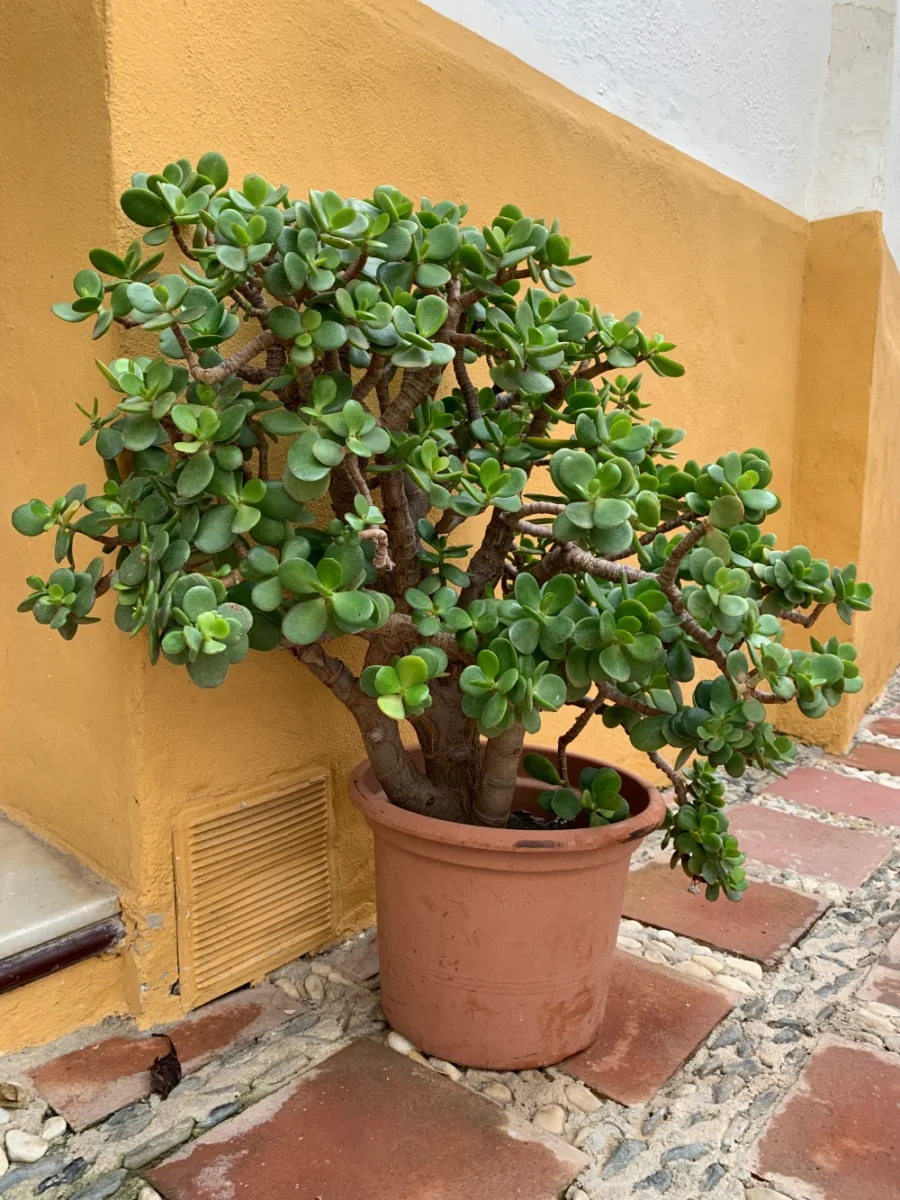
Water And Humidity Requirements
Proper watering is crucial for jade plant success. These succulents store water in their leaves and stems, making them drought-tolerant but susceptible to overwatering. Allow the soil to dry completely between waterings—typically every 2-3 weeks during growing seasons and less frequently in winter.
When watering, soak the soil thoroughly until water runs from the drainage holes, then empty the saucer promptly. This approach encourages deep root growth rather than shallow surface roots that develop with light, frequent watering.
Signs of overwatering include:
- Soft, mushy leaves
- Leaf drop
- Yellowing leaves
- Black spots on leaves
Signs of underwatering:
- Wrinkled, shrivelled leaves
- Brown, dry leaf tips
- Slow or stunted growth
Jade plants prefer average indoor humidity and don’t require misting or humidifiers. In fact, excessive humidity can promote fungal issues. Good air circulation around the plant helps maintain appropriate moisture levels and prevents pest problems.
During winter months, reduce watering significantly—perhaps once monthly—as the plant enters a semi-dormant phase with minimal growth.
Pruning And Leaf Maintenance
Regular pruning keeps jade plants compact and encourages bushier growth. Spring is the optimal time for pruning when the plant is entering its active growth phase. Use clean, sharp scissors or pruning shears to make cuts just above a leaf node or lateral branch.
Don’t hesitate to be quite assertive with pruning—jade plants respond well to trimming and will branch out where cuts are made. This technique helps create fuller, more attractive specimens rather than tall, leggy plants that may become top-heavy.
Remove any dead or yellowing leaves by gently twisting them from the stem. These can indicate watering issues or simply be part of the plant’s natural cycle. Regularly dust the leaves with a soft, damp cloth to keep them glossy and photosynthesising efficiently.
For plants becoming unwieldy or top-heavy, prune back the main stems to reduce height and encourage a more balanced structure. Pruned stems can be saved for propagation rather than discarded.
Turning your plant quarterly ensures even growth on all sides, preventing it from leaning permanently toward light sources.
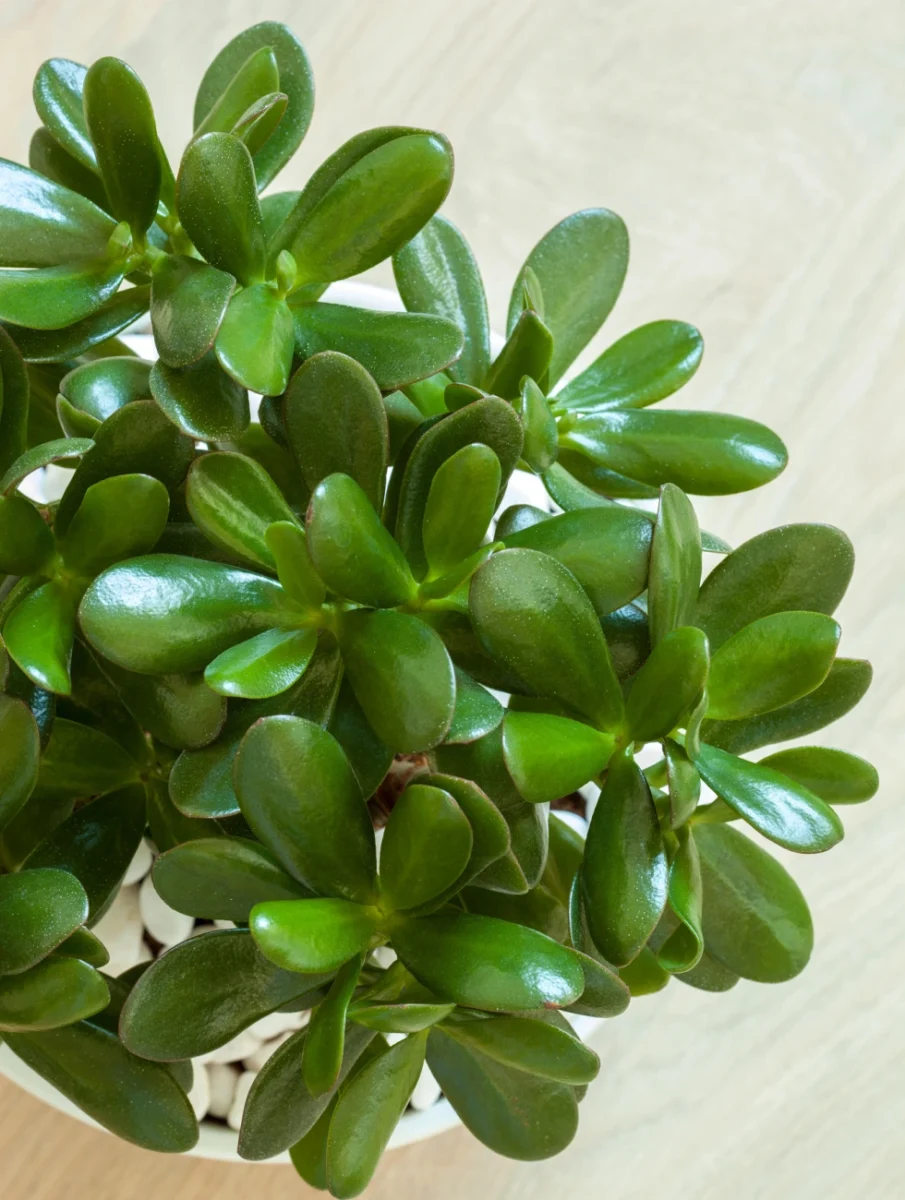
Propagation
Jade plants are remarkably easy to propagate, offering multiple methods to expand your collection or share with friends. Stem cuttings are the most reliable approach, particularly using stems that are at least 5-8cm long with several leaf nodes.
Stem cutting method:
- Take a cutting with clean scissors, removing lower leaves to expose 2-3cm of bare stem
- Allow the cut end to callus over for 2-3 days
- Insert the stem into slightly moist succulent soil
- Wait 3-4 weeks before gentle watering, allowing roots to establish
Leaf propagation works too, though it’s slower. Simply place a plump, healthy leaf on dry soil with the cut end just touching the surface. Within weeks, tiny roots will form, followed eventually by a new plantlet.
The most successful propagation occurs during spring and summer when the plant is actively growing. Keep new cuttings in bright, indirect light but away from intense direct sun until established. Avoid overwatering new propagations—moist but never soggy soil is crucial for root development.
Patience is essential with jade plant propagation. While roots may form relatively quickly, visible growth above soil level often takes several months to become substantial.
Winter Care Of Jade Plant
Jade plants require special attention during winter months to thrive indoors. These resilient succulents need adjustments to their care routine when temperatures drop and daylight hours decrease.
Water your jade plant less frequently in winter. The soil should go mostly dry, but not completely parched before watering again. For most indoor environments, this typically means watering once a month rather than the more frequent summer schedule.
Temperature management is crucial for winter success. Keep your jade plant in a room that stays between 10-21°C. Avoid placing it near radiators, heaters or draughty windows which can cause stress to the plant.
Light requirements remain important even in darker months. Position your jade near a south-facing window where it can receive at least 4 hours of bright, indirect sunlight daily. In particularly dark UK winters, consider supplementing with grow lights.
Winter Jade Plant Care Tips:
- Stop fertilising completely during winter months
- Watch for wrinkled leaves as a sign the plant needs water
- Inspect regularly for pests which can become problematic in dry indoor environments
- Keep away from cold window sills overnight when temperatures drop
Humidity levels in heated homes can drop significantly in winter. While jade plants tolerate dry air better than most houseplants, occasional misting can be beneficial, especially if your home uses central heating.
Repotting should be avoided during winter. Your jade plant is in a semi-dormant state and won’t appreciate the disturbance. Save any repotting or major pruning for spring when active growth resumes.
Common Problems And Solutions
Jade plants are generally robust, but they can face several issues that impact their health. Being aware of these common problems will help you keep your plant thriving.
Overwatering is perhaps the most frequent issue jade plant owners encounter. When overwatered, leaves become soft and mushy before eventually falling off. To remedy this, water only when the soil is completely dry to the touch and ensure your pot has proper drainage.
Root rot develops as a consequence of overwatering. If you notice a foul smell or see the lower stem turning black, you’ll need to act quickly. Remove the plant from its pot, trim away affected roots, and repot in fresh, well-draining soil.
Common pests that trouble jade plants include:
- Mealybugs: These appear as white, cotton-like patches on stems and leaves
- Spider mites: Tiny pests that cause yellowing and fine webbing
- Scale: Small, brownish bumps that attach to stems and leaves
For pest control, wipe affected areas with a cotton swab dipped in rubbing alcohol or use insecticidal soap. For serious infestations, you might need to isolate the plant and treat it regularly.
Leaf spots could indicate fungal issues, typically arising from water splashing on leaves or high humidity. Improve air circulation around your plant and avoid getting water on the leaves when watering.
Toxicity is another concern to be aware of, especially if you have pets or small children. Jade plants contain compounds that can cause mild stomach upset if ingested, so place them out of reach.
Other Similar Plants To Grow
If you enjoy growing jade plants, there are several other succulents with similar care needs that would make excellent additions to your collection. These plants thrive under comparable conditions and can create a beautiful display alongside your jade.
Graptopetalum species work brilliantly with jade plants when grown outdoors. They enjoy similar sunny conditions and have the same low water requirements, making them ideal companions.
Sedum varieties, with their fleshy leaves and drought tolerance, complement jade plants perfectly. They come in various shapes and colours, adding visual interest to your succulent collection.
Echeveria plants offer stunning rosette formations and a similar care routine to jade plants. They prefer bright light and infrequent watering, making them excellent houseplants for beginners.
Aeonium varieties provide architectural interest with their distinctive rosette shapes. They thrive in the same sunny spots as jade plants but may need slightly more water during active growth periods.
Portulacaria Afra (Dwarf Jade or Elephant Bush) is often confused with true jade plants but belongs to a different genus. The main difference is its growth habit, which tends to be more shrub-like and spreading compared to the tree-like form of Crassula ovata.
For indoor growing, consider these similar houseplants:
| Plant Name | Light Needs | Watering | Special Features |
|---|---|---|---|
| Echeveria | Bright, indirect | When soil dries | Rosette formation |
| Sedum | Bright light | Sparingly | Trailing varieties available |
| Aeonium | Bright, indirect | Slightly more than jade | Dramatic rosettes |
| Portulacaria Afra | Similar to jade | Similar to jade | More compact growth |
Many of these plants can be propagated from leaf cuttings just like jade plants, making it easy to expand your collection without spending a fortune.
Martin Cole has been an avid plant lover and gardener for more than 20 years and loves to talk and write about gardening. In 2006 he was a finalist in the BBC Gardener of the Year competition. He is a member of the National dahlia Society.
He previously lived in London and Sydney, Australia, where he took a diploma course in Horticultural studies and is now based in North Berwick in Scotland. He founded GardeningStepbyStep.com in 2012. The website is aimed at everybody who loves plants or has been bitten by the gardening bug and wants to know more.
Gardening Step by Step has been cited by Thompson and Morgan, the UK’s largest mail order plant retailer, as a website that publishes expert gardening content.


